Món này tụi mình ăn lần đầu ở Singapore tại quán Song Fa ngay khu Clark Quay, bị ấn tượng và lần nào đến Sing cũng ăn lại món này. Số quán làm món này ở Việt Nam không nhiều, tụi mình có ăn thử vài quán nhưng hầu như đều không ưng, không cảm nhận được hương vị như hồi ăn bên Sing. Founder Bak Kut Teh là quán lâu đời ở Sing, nằm trong chuỗi đàng hoàng nên tụi mình ăn thử xem sao.
Địa chỉ:
Tầng trệt, TTTM RomeA, 117 Nguyễn Đình Chiểu, P. 6, Quận 3, TP. HCM
Sau đây là 1 vài đánh giá của tụi mình:
Vị trí: nằm trong trung tâm thương mại ngay góc ngã 4 Nguyễn Đình Chiểu – Trương Định. Điểm bất lợi là trung tâm thương mại này quá vắng nên quán ít nhiều cũng bị ảnh hưởng. Giữ xe ở tầng hầm, giá 5k, đi lên tầng trệt là thấy quán.
Không gian: quán rộng rãi, sạch sẽ, trong trung tâm thương mại nên máy lạnh mát rượi, thậm chí hơi vắng nên mình thấy hơi bị lạnh quá (với mình). Trên cửa kiếng có dán hình mấy người nổi tiếng (bên Sing) đến ăn tại quán.
Phục vụ:
Món lên không quá nhanh nhưng lên đều, nhân viên dễ thương, phục vụ tốt.
Món ăn:
Tụi mình đi 4 người nên kêu bình trà lớn uống chung. Món này béo, nhiều thịt uống với nước trà dễ tiêu. Nói là bán Bak Kut Teh nhưng mình thấy thực đơn nước uống, tráng miệng ở đây khá là nhiều sự lựa chọn, lạ, món nào nghe cũng muốn thử 1 chút đó.
Mình xin nhận xét chung về món Bak Kut Teh tại đây, nước dùng là giống nhau (nước sườn trà hầm) chỉ khác ở loại thịt thôi. Nước hầm đậm đà, ngọt thanh, thơm, vẫn cảm nhận 1 chút mùi ngai ngái của lòng heo (nhưng không đậm mùi, chỉ 1 chút thôi). Nước này húp vô cảm giác tỉnh táo cả người vì nó ấm, nóng lâu. Hết nước hầm nhân viên sẽ tới châm thêm (miễn phí). Thịt được hầm rục lắm nên mềm, thấm, thơm, chấm thêm chút hắc xì dầu cho tăng hương vị.

Sườn ngắn đặc biệt – 158k 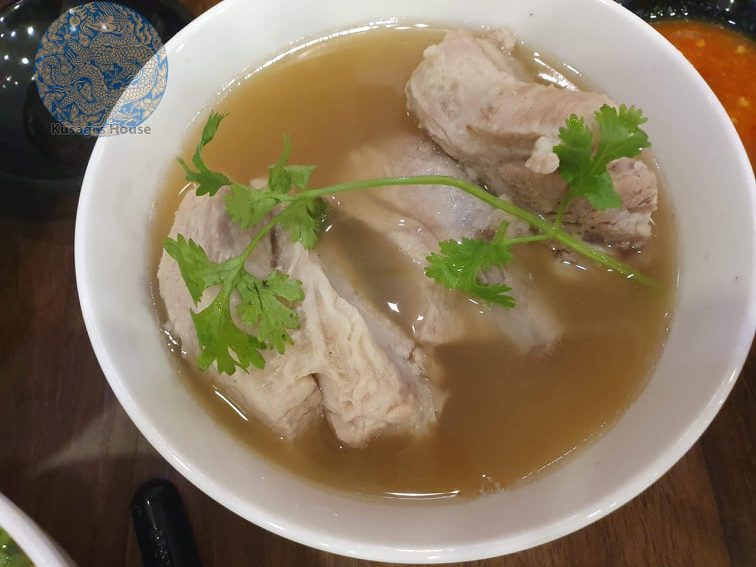
Sườn miếng – 118k
Giò heo hầm – size M (Pig Trotter): mềm rục (từ thịt tới da), thơm, đậm đà, thấm gia vị (nhìn màu sắc là thấy thấm lắm luôn), béo nhưng không gây ngán lắm.
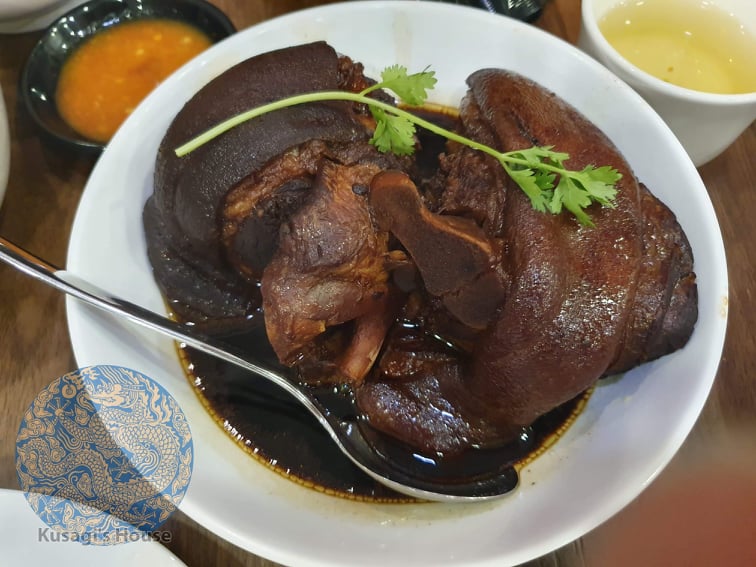
Giò heo hầm (M) – 158k 
Sườn cọng đặc biệt – 178k
Cải ngọt sốt dầu hào (Choy Sim with Oyster) & Mì (Vercimelli Noodles Soup): cải xào với tỏi nên thơm mùi tỏi, thấm dầu hào, xào kiểu Hoa dầu nhiều nên hơi ngán chút. Mì sợi mảnh (giống mì chỉ) nhưng dai, nước súp trong mì hơi lạt hơn so với nước súp sườn.
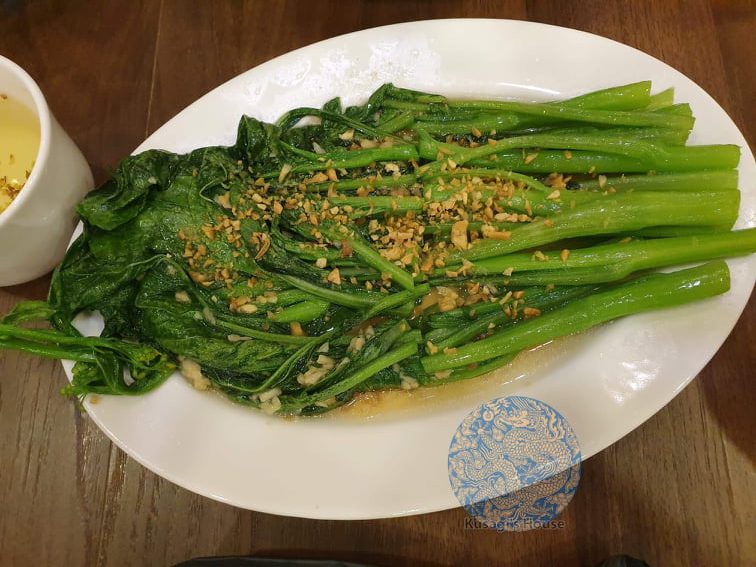
Cải ngọt sốt dầu hào – 58k 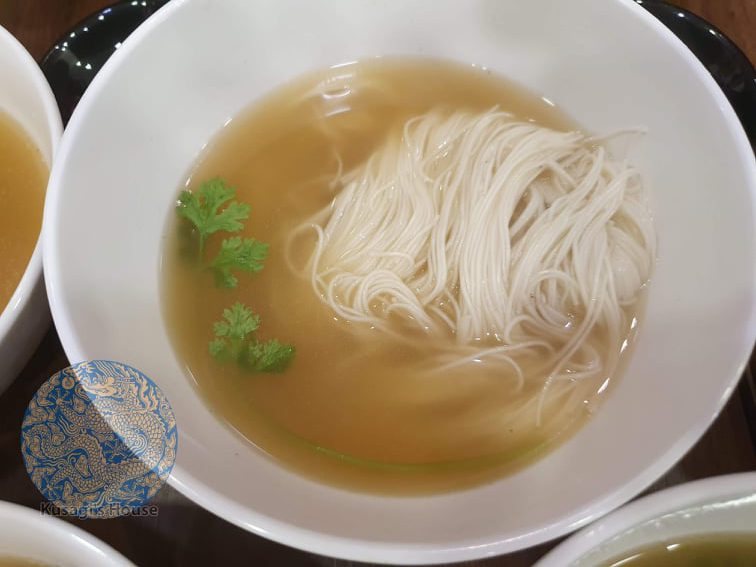
Mì – 16k 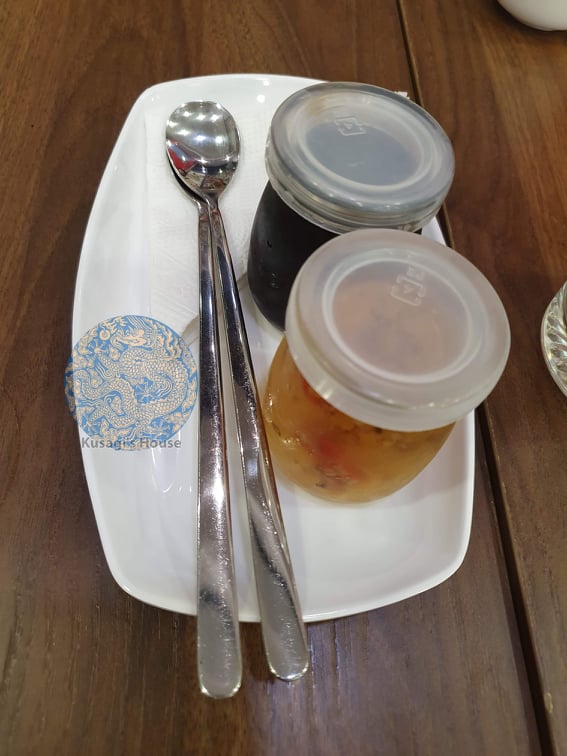
- Bánh quế hoa (Osmathus Royal Jelly): nhìn tên tiếng Anh và món ăn cỡ nào cũng là rau câu, không hiểu sao gọi là bánh. Rau câu ăn mát, thanh, có kỷ tử, bông cúc, thơm.
- Quy linh cao (Qui Ling Gao): món sâm đen của người Hoa, món này ăn cũng mát, vị hơi nhẫn đắng nên ăn kèm mật ong, ở đây làm vị cho dịu đi để dễ ăn rồi.
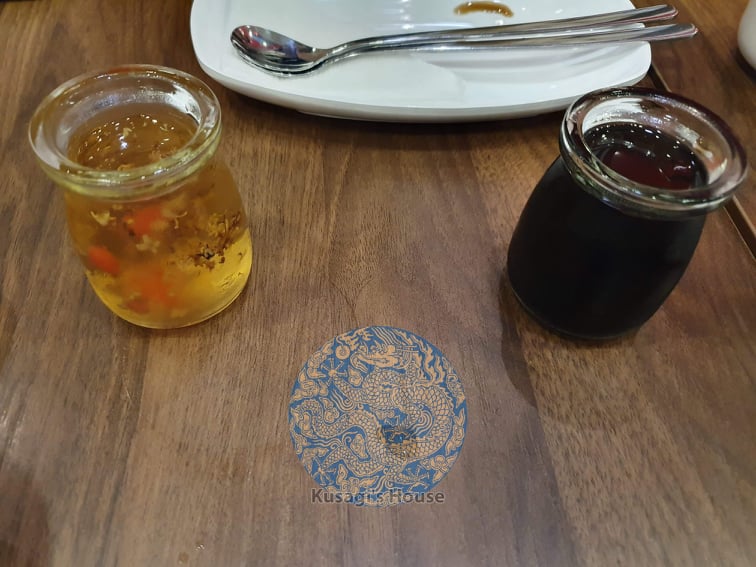
Điểm trừ: thực ra đối với quán này ở Việt Nam sẽ không có sự so sánh nhiều vì hiện tại mình chưa tìm ra quán bán món này ngon hơn ở VN. Mình có ăn thử quán này bên Sing thì thấy là vị đưa về đây gần như nguyên vẹn, không có khác biệt nhiều. Vì mình ấn tượng với quán Song Fa bên kia nên sẽ có chút sự so sánh như sau:
- Nước súp không ấm và hơi ấm khi húp nước súp ở đây không kéo dài lâu như khi mình ăn ở Song Fa (có lẽ vì bên kia có nhiều tiêu và 1 số gia vị hơn 1 chút)
- Nước chấm cũng là hắc xì dầu pha, mình không chắc hắc xì dầu bên kia có bí quyết hay pha riêng không? Nhưng khi pha hắc xì dầu và giấm chấm rất đậm đà, vừa miệng, mùi nước chấm không quá át miếng sườn. Ở đây phần nước chấm chưa làm được như vậy.
Giá cả: hơi cao, thời điểm tụi mình đi ăn khá là lâu rồi nên không chắc bây giờ còn giá này không, nhất là những tháng gần đây giá thịt heo đang lên cao. Chất lượng thì quá ổn, chưa tìm được quán nào bán món này tại VN ngon. Thiệt hại: ~900k/ 4 người. Giá trên hình/menu chưa bao gồm 10% VAT.
Cảm ơn các bạn đã đọc bài viết. Phía trên là vài nhận xét của mình tại quán này. Hẹn gặp các bạn ở bài review tiếp theo. Mùa này hàng quán đóng cửa nhiều, chủ yếu chỉ còn delivery, sức khoẻ và sự an toàn của bản thân và cộng đồng vẫn là trên hết. Mọi người giữ gìn sức khoẻ, cố gắng vượt qua đại dịch này 🙂
Usagi


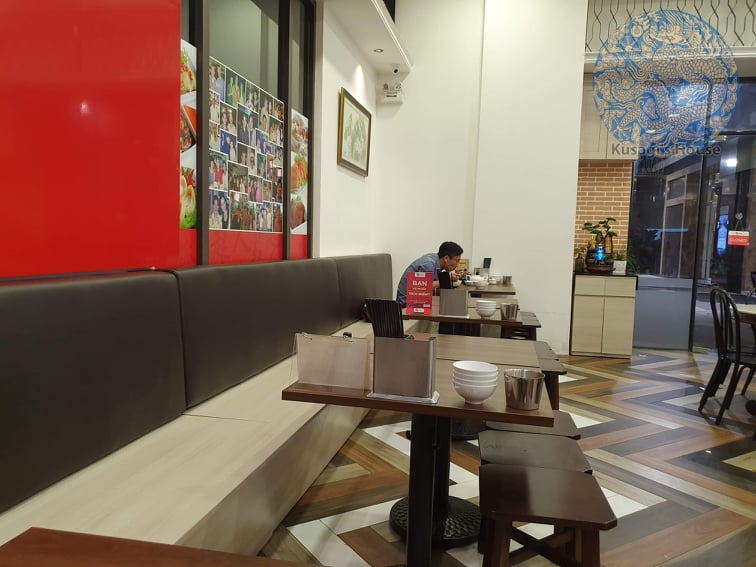
Tesla is bringing its electric cars to oil-rich Saudi Arabia amid falling global sales
aperture finance
Tesla will start selling its electric vehicles in Saudi Arabia, entering the Gulf region’s largest economy as the company’s global sales are sliding and CEO Elon Musk courts controversy with his role in the US government.
The carmaker announced Wednesday that it would host a launch event in the kingdom on April 10, where it will showcase its EVs. Attendees will also have the chance to “experience the future of autonomous driving with Cybercab and meet Optimus, our humanoid robot, as we showcase what’s next in AI and robotics,” Tesla (TSLA) said.
Tesla may struggle to gain market share in oil-rich Saudi Arabia as EVs make up a little over 1% of all car sales in the country, according to a report by consultancy PwC published in September.
Tesla’s entry into the new market comes as the company fights battles on several fronts.
Last year, it recorded the first annual decline in sales in its history as a public company, posting a drop of 1%.
The company is facing intensifying competition in China, the world’s largest auto market. On Tuesday, BYD, a Chinese maker of electric and hybrid cars, reported $107 billion in annual sales for 2024, beating the near-$98 billion notched by Tesla.
And last week, BYD unveiled an ultra-fast charging system, which it said was capable of adding 250 miles (402 km) of range in just five minutes, easily outdoing Tesla’s charging technology. Tesla’s Superchargers take 15 minutes to charge an EV, providing a range of 200 miles.
Tesla has also suffered slumping sales in Europe. In February, the carmaker sold around 40% fewer vehicles on the continent compared with the same month in 2024, according to the European Automobile Manufacturers’ Association.
While the Cumberland sample may contain longer chains of fatty acids, SAM is not designed to detect them. But SAM’s ability to spot these larger molecules suggests it could detect similar chemical signatures of past life on Mars if they’re present, Williams said.
convex finance
“Curiosity is not a life detection mission,” Freissinet said. “Curiosity is a habitability detection mission to know if all the conditions were right … for life to evolve. Having these results, it’s really at the edge of the capabilities of Curiosity, and it’s even maybe better than what we had expected from this mission.”
Before sending missions to Mars, scientists didn’t think organic molecules would be found on the red planet because of the intensity of radiation Mars has long endured, Glavin said.
Curiosity won’t return to Yellowknife Bay during its mission, but there are still pristine pieces of the Cumberland sample aboard. Next, the team wants to design a new experiment to see what it can detect. If the team can identify similar long-chain molecules, it would mark another step forward that might help researchers determine their origins, Freissinet said.
“That’s the most precious sample we have on board … waiting for us to run the perfect experiment on it,” she said. “It holds secrets, and we need to decipher the secrets.”
Briony Horgan, coinvestigator on the Perseverance rover mission and professor of planetary science at Purdue University in West Lafayette, Indiana, called the detection “a big win for the whole team.” Horgan was not involved the study.
“This detection really confirms our hopes that sediments laid down in ancient watery environments on Mars could preserve a treasure trove of organic molecules that can tell us about everything from prebiotic processes and pathways for the origin of life, to potential biosignatures from ancient organisms,” Horgan said.
Dr. Ben K.D. Pearce, assistant professor in Purdue’s department of Earth, atmospheric, and planetary sciences and leader of the Laboratory for Origins and Astrobiology Research, called the findings “arguably the most exciting organic detection to date on Mars.” Pearce did not participate in the research.
Arctic auroras
ethena
For getting around during winter, the Inuit here nowadays prefer snowmobiles, although they still keep their sled dogs. During winter they’ll offer intrepid visitors, wrapped up warm against the deep-freeze temperatures, dog-sledding jaunts. These can last either an hour or be part of expeditions over several days, sometimes with the added experience of learning how to build an igloo. Sisimiut on the west coast and Tasilaq in the southeast are active winter centers for dog sledding.
Winter’s most stellar attraction, though, is northern lights watching. With little urban light pollution, Greenland is a dark canvas for spectacular displays, and aurora borealis-watching vacations are becoming more popular.
Staying outdoors, Greenland is developing a reputation among adventure enthusiasts: from long-distance skiing expeditions and heliskiing on the icecap to hiking the 100-mile-long Arctic Circle Trail from Kangerslussuaq, where firearms need to be carried for warning shots in case of polar bear encounters.
Life is definitely changing here. The climate crisis is eating away at its icecap and Greenland may well end up as a pawn in a game of geopolitical chess. But for now, the bright glare of international attention should shine a favorable light on one of the wildest travel destinations on Earth.
Travel writer Mark Stratton is an Arctic specialist who has traveled to Greenland six times and counting. He’s marveled at the aurora borealis, sailed to Disko Island, dog-sledded with the Inuit, and once got stuck in an icefloe.
Curiosity has maintained pristine pieces of the Cumberland sample in a “doggy bag” so that the team could have the rover revisit it later, even miles away from the site where it was collected. The team developed and tested innovative methods in its lab on Earth before sending messages to the rover to try experiments on the sample.
changelly exchange
In a quest to see whether amino acids, the building blocks of proteins, existed in the sample, the team instructed the rover to heat up the sample twice within SAM’s oven. When it measured the mass of the molecules released during heating, there weren’t any amino acids, but they found something entirely unexpected.
An intriguing detection
The team was surprised to detect small amounts of decane, undecane and dodecane, so it had to conduct a reverse experiment on Earth to determine whether these organic compounds were the remnants of the fatty acids undecanoic acid, dodecanoic acid and tridecanoic acid, respectively.
The scientists mixed undecanoic acid into a clay similar to what exists on Mars and heated it up in a way that mimicked conditions within SAM’s oven. The undecanoic acid released decane, just like what Curiosity detected.
Each fatty acid remnant detected by Curiosity was made with a long chain of 11 to 13 carbon atoms. Previous molecules detected on Mars were smaller, meaning their atomic weight was less than the molecules found in the new study, and simpler.
“It’s notable that non-biological processes typically make shorter fatty acids, with less than 12 carbons,” said study coauthor Dr. Amy Williams, associate professor of geology at the University of Florida and assistant director of the Astraeus Space Institute, in an email. “Larger and more complex molecules are likely what are required for an origin of life, if it ever occurred on Mars.”
Iceberg flotillas
debridge
Located on the west coast, Ilulissat is a pretty halibut- and prawn-fishing port on a dark rock bay where visitors can sit in pubs sipping craft beers chill-filtered by 100,000-year-old glacial ice.
It’s a place to be awed by the UNESCO World Heritage Icefjord where Manhattan skyscraper-sized icebergs disgorge from Greenland’s icecap to float like ghostly ships in the surrounding Disko Bay.
Small boats take visitors out to sail closely among the bay’s magnificent iceberg flotilla. But not too close.
“I was on my boat once and saw one of these icebergs split in two. The pieces fell backwards into the sea and created a giant wave,” said David Karlsen, skipper of the pleasure-boat, Katak. “…I didn’t hang around.”
Disko Bay’s other giants are whales. From June to September breaching humpback whales join the likes of fin and minke whales feasting on plankton. Whale-watching is excellent all around Greenland’s craggy coastline.
Whales are eaten here. Visitors shouldn’t be surprised to encounter the traditional Greenlandic delicacy of mattak — whale-skin and blubber that when tasted is akin to chewing on rubber. Inuit communities have quotas to not only hunt the likes of narwhals but also polar bears, musk-ox and caribou — which can also appear on menus.
‘For the public to enjoy’
keplr wallet
The museum’s history starts in 1998, when Sheikh Faisal Bin Qassim Al Thani opened a building to the public on his farm some 20 kilometers (12 miles) north of Qatari capital Doha.
A distant relative of Qatar’s ruling family, founder and chairman of Al Faisal Holdings (one of Qatar’s biggest conglomerates), and a billionaire whose business acumen had him recognized as one of the most influential Arab businessmen in the world, Sheikh Faisal had already amassed a substantial private collection of historically important regional artifacts, plus a few quirky pieces of interest, allowing visitors an intimate look into Qatari life and history.
In an interview with Qatari channel Alrayyan TV in 2018, Sheikh Faisal said that the museum started as a hobby.
“I used to collect items whenever I got the chance,” he said. “As my business grew, so did my collections, and soon I was able to collect more and more items until I decided to put them in the museum for the public to enjoy.”
His private cabinet of curiosities has since evolved into a 130-acre complex. Through the fort-like entrance gate lies an oryx reserve, an impressive riding school and stables, a duck pond and a mosque built with a quirky leaning minaret. There’s now even a five-star Marriott hotel, two cafes and the Zoufa restaurant serving modern Lebanese cuisine.
Of course, there’s also the super-sized museum, with a recently-opened car collection housing everything from vintage Rolls-Royces to wartime Jeeps and colorful Buicks. Outside you’ll find peacocks roaming the grounds, and signs warning drivers to be aware of horses and ostriches.
Visitors to the FBQ museum are free to explore the grounds and can even enter the stables to pat the horses.
A long time in the making
Curiosity landed in Gale Crater on August 6, 2012. More than 12 years later, the rover has driven over 21 miles (34 kilometers) to ascend Mount Sharp, which is within the crater. The feature’s many layers preserve millions of years of geological history on Mars, showing how it shifted from a wet to a dry environment.
celer network
Perhaps one of the most valuable samples Curiosity has gathered on its mission to understand whether Mars was ever habitable was collected in May 2013.
The rover drilled the Cumberland sample from an area within a crater called Yellowknife Bay, which resembled an ancient lake bed. The rocks from Yellowknife Bay so intrigued Curiosity’s science team that it had the rover drive in the opposite direction to collect samples from the area before heading to Mount Sharp.
Since collecting the Cumberland sample, Curiosity has used SAM to study it in a variety of ways, revealing that Yellowknife Bay was once the site of an ancient lake where clay minerals formed in water. The mudstone created an environment that could concentrate and preserve organic molecules and trapped them inside the fine grains of the sedimentary rock.
Freissinet helped lead a research team in 2015 that was able to identify organic molecules within the Cumberland sample.
The instrument detected an abundance of sulfur, which can be used to preserve organic molecules; nitrates, which are essential for plant and animal health on Earth; and methane composed of a type of carbon associated with biological processes on Earth.
“There is evidence that liquid water existed in Gale Crater for millions of years and probably much longer, which means there was enough time for life-forming chemistry to happen in these crater-lake environments on Mars,” said study coauthor Daniel Glavin, senior scientist for sample return at NASA’s Goddard Space Flight Center in Greenbelt, Maryland, in a statement.
Curiosity rover makes ‘arguably the most exciting organic detection to date on Mars’
bungee exchange
The NASA Curiosity rover has detected the largest organic molecules found to date on Mars, opening a window into the red planet’s past. The newly detected compounds suggest complex organic chemistry may have occurred in the planet’s past — the kind necessary for the origin of life, according to new research.
The organic compounds, which include decane, undecane and dodecane, came to light after the rover analyzed a pulverized 3.7 billion-year-old rock sample using its onboard mini lab called SAM, short for Sample Analysis at Mars.
Scientists believe the long chains of molecules could be fragments of fatty acids, which are organic molecules that are chemical building blocks of life on Earth and help form cell membranes. But such compounds can also be formed without the presence of life, created when water interacts with minerals in hydrothermal vents.
The molecules cannot currently be confirmed as evidence of past life on the red planet, but they add to the growing list of compounds that robotic explorers have discovered on Mars in recent years. A study detailing the findings was published Monday in the journal Proceedings of the National Academy of Sciences.
The detection of the fragile molecules also encourages astrobiologists that if any biosignatures, or past signs of life, ever existed on Mars, they are likely still detectable despite the harsh solar radiation that has bombarded the planet for tens of millions of years.
“Ancient life, if it happened on Mars, it would have released some complex and fragile molecules,” said lead study author Dr. Caroline Freissinet, research scientist at the French National Centre for Scientific Research in the Laboratory for Atmospheres, Observations, and Space in Guyancourt, France. “And because now we know that Mars can preserve these complex and fragile molecules, it means that we could detect ancient life on Mars.”
Everyone is talking about Greenland. Here’s what it’s like to visit
cow fi
A few months ago, Greenland was quietly getting on with winter, as the territory slid deeper into the darkness that envelops the world’s northerly reaches at this time of year.
But President Donald Trump’s musings about America taking over this island of 56,000 largely Inuit people, halfway between New York and Moscow, has seen Greenland shaken from its frozen Arctic anonymity.
Denmark, for whom Greenland is an autonomous crown dependency, has protested it’s not for sale. Officials in Greenland, meanwhile, have sought to assert the territory’s right to independence.
The conversation continues to intensify. A contentious March 28 visit to a US military installation by Usha Vance, the second lady, accompanied by her husband, Vice President JD Vance, was the latest in a series of events to focus attention on Trump’s ambitions for Greenland.
The visit was originally planned as a cultural exchange, but was shortened following complaints from Greenland Prime Minister Mute B. Egede.
Had the Vances prolonged their scheduled brief visit, they would’ve discovered a ruggedly pristine wildernesses steeped in rich Indigenous culture.
An inhospitable icecap several miles deep covers 80% of Greenland, forcing the Inuit to dwell along the shorelines in brightly painted communities. Here, they spend brutally cold winters hunting seals on ice under the northern lights in near perpetual darkness. Although these days, they can also rely on community stores.
The problem for travelers over the years has been getting to Greenland via time-consuming indirect flights. That’s changing. Late in 2024, the capital Nuuk opened a long-delayed international airport. From June 2025, United Airlines will be operating a twice-weekly direct service from Newark to Nuuk.
Two further international airports are due to open by 2026 — Qaqortoq in South Greenland and more significantly in Ilulissat, the island’s only real tourism hotspot.
https://jak-obstawiac-hokej.hodowcyroz.pl/
This website has lots of really useful stuff on it. Thanks for informing me.
Great post. I was checking constantly this blog and I’m impressed! Very useful info specifically the last part 🙂 I care for such info much. I was looking for this certain information for a very long time. Thank you and good luck.
Hi there I am so happy I found your blog, I really found you by mistake, while I was browsing on Aol for something else, Anyhow I am here now and would just like to say many thanks for a marvelous post and a all round entertaining blog (I also love the theme/design), I don’t have time to browse it all at the moment but I have bookmarked it and also added your RSS feeds, so when I have time I will be back to read a lot more, Please do keep up the great work.|
acyclovir 400mg pills – zyloprim 300mg cost buy generic crestor for sale
I appreciate how well-researched and detailed your posts are It’s evident that you put a lot of time and effort into providing valuable information to your readers
motilium 10mg cheap – cyclobenzaprine 15mg ca order flexeril without prescription
Polygon Bridge is the most affordable bridge I’ve used.
70918248
References:
sarm steroids (Everette)
order motilium 10mg pills – cheap motilium flexeril order
Thanks for posting this. Looking for these resources 😀